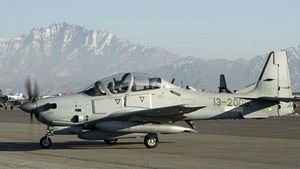The U.S. Department of Defense (DoD) has extended a so-called indefinite-delivery/indefinite quantity contract with Embraer/Sierra Nevada Corporation for the delivery of A-29 Super Tucano light attack aircraft, the DoD announced on September 4.
The DoD states that the new $1.808 billion indefinite-delivery/indefinite quantity contract, will be extended from August 2019 to December 2024. As of this month, the Pentagon has ordered 26 A-29 Super Tucano aircraft for the Afghan Air Force with 22 A-29s delivered so far. (The DoD placed its last order for six A-29s in October 2017.)
Nine aircraft are currently used to train 30 AAF pilots and 90 ground staff, including maintenance crews, at Moody Air Force Base in Georgia. The training, part of the U.S. Air Force’s Light Air Support/A-29 Afghanistan Program, is overseen by the U.S. Air Force’s 81st Fighter Squadron.
The remaining 12 aircraft are currently deployed with the AAF in Afghanistan, where its main mission is close-air-support during ground operation of the Afghan National Defense and Security Forces. (One A-29 crashed during a training exercise and has yet to be replaced.)
A-29s were originally supposed to deploy to the battlefields of Afghanistan much earlier, as I explained elsewhere (See: “Confirmed: First Four A-29 Light Attack Aircraft Arrive in Afghanistan”):
Brazilian aircraft maker Embraer and its U.S. partner Sierra Nevada Corporation where initially awarded the contract to supply 20 A-29 light attack aircraft in 2011. However, the contract was cancelled in 2012 due to a dissatisfaction of USAF leadership “with the quality of the documentation supporting the award decision.” However, the contract was re-awarded to Embraer and Sierra Nevada Corporation in 2013.
The aircraft is ideally suited for the war in Afghanistan. “The A-29 Super Tucano is a turboprop aircraft specifically designed for counter-insurgency operations and can be equipped with a wide array of bombs (including precision guided munitions) and machine guns,” I explained elsewhere. “The aircraft is fairly cheap to operate with one hour of flying time costing around $1,000.”
A-29s can carry up to two 500-pound (226 kilogram) conventional or smart freefall bombs, short-range air-to-air missiles, machine guns and rockets. The aircraft can also launch GBU-58 laser-guided bombs.
The per-unit price per A-29 is around $18 million making it relatively affordable for the AAF.
A-29s are responsible for approximately one third of all airstrikes conducted by the AAF. “The AAF launches on average 15 airstrikes per day in support of ground operations in the country,” I explained in April. “Out of the 15, five are typically conducted by A-29 Super Tucano light attack aircraft.” Notably, the readiness rate for all AAF aircraft including A-29s remains classified.
The AAF has been under criticism for causing excessive civilian casualties over the past years. A report by the U.N. Assistance Mission in Afghanistan found that 1,692 Afghan civilians were killed in the first six months of 2018.
































